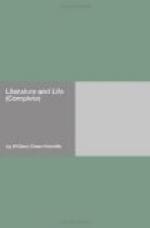II
I should, indeed, prefer another line of Keats’s, if I were to profess any formulated creed, and should feel much safer with his “Beauty is Truth, Truth Beauty,” than even with my friend’s reformation of the more quoted verse. It brings us back to the solid ground taken by Mr. Symonds, which is not essentially different from that taken in the great Mr. Burke’s Essay on the Sublime and the Beautiful—a singularly modern book, considering how long ago it was wrote (as the great Mr. Steele would have written the participle a little longer ago), and full of a certain well-mannered and agreeable instruction. In some things it is of that droll little eighteenth-century world, when philosophy had got the neat little universe into the hollow of its hand, and knew just what it was, and what it was for; but it is quite without arrogance. “As for those called critics,” the author says, “they have generally sought the rule of the arts in the wrong place; they have sought among poems, pictures, engravings, statues, and buildings; but art can never give the rules that make an art. This is, I believe, the reason why artists in general, and poets principally, have been confined in so narrow a circle; they have been rather imitators of one another than of nature. Critics follow them, and therefore can do little as guides. I can judge but poorly of anything while I measure it by no other standard than itself. The true standard of the arts is in every man’s power; and an easy observation of the most common, sometimes of the meanest things, in nature will give the truest lights, where the greatest sagacity and industry that slights such observation must leave us in the dark, or, what is worse, amuse and mislead us by false lights.”
If this should happen to be true and it certainly commends itself to acceptance—it might portend an immediate danger to the vested interests of criticism, only that it was written a hundred years ago; and we shall probably have the “sagacity and industry that slights the observation” of nature long enough yet to allow most critics the time to learn some more useful trade than criticism as they pursue it. Nevertheless, I am in hopes that the communistic era in taste foreshadowed by Burke is approaching, and that it will occur within the lives of men now overawed by the foolish old superstition that literature and art are anything but the expression of life, and are to be judged by any other test than that of their fidelity to it. The time is coming, I hope, when each new author, each new artist, will be considered, not in his proportion to any other author or artist, but in his relation to the human nature, known to us all, which it is his privilege, his high duty, to interpret. “The true standard of the artist is in every man’s power” already, as Burke says; Michelangelo’s “light of the piazza,” the glance of the common eye, is and always was the best light on a statue; Goethe’s




